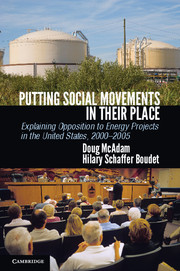 Putting Social Movements in their Place
Putting Social Movements in their Place The Emergence of Regional Movements against Liquefied Natural Gas
Published online by Cambridge University Press: 05 June 2012
In the previous two chapters we took up issues – movement emergence and outcomes – to which scholars have devoted a great deal of attention. By contrast, in this chapter, we focus on a topic about which we know comparatively little. We refer to “scale shift,” or the geographic expansion or contraction of contention. In a 2005 article, McAdam and colleagues lament what they see as the “distorting lens” of social movement scholarship. More specifically, they fault movement scholars for continuing to propound a stylized view of social movements rooted in the field’s early preoccupation with the New Left/New Social Movements of the 1960s and 1970s. This “stylized view,” they contend, equates movements with the following four features:
Disruptive protest in public settings,
Urban and/or campus-based movement activities,
Contentious claim making by disadvantaged minorities, and
Loosely coordinated national struggles over political issues.
They go on to present data from their time-series analysis of “protest events” in Chicago between 1970 and 2000 in an effort to show that all of these features are wildly atypical of movement activity, especially during the most recent period.
In this chapter we focus on the last of these stylized elements. McAdam and colleagues (2005) frame their discussion of the element in the following way: “National movements tend to be the modal object of study for movement analysts. So, for example, for the U.S. we have extensive literatures on such national struggles as: African-American civil rights, women’s, environmental, pro-choice, pro-life, among others. Does the empirical attention accorded [these] national movements match their actual proportion in the population of all contentious events?” (10). Based on their data, the answer is unambiguous. “A scant six percent of all . . . events were coded as ‘national’ in their focus . . .. In contrast . . . nearly three-quarters of the total were judged to be focused on ‘city’ . . . or neighborhood issues” (10–11).
To save this book to your Kindle, first ensure [email protected] is added to your Approved Personal Document E-mail List under your Personal Document Settings on the Manage Your Content and Devices page of your Amazon account. Then enter the ‘name’ part of your Kindle email address below. Find out more about saving to your Kindle.
Note you can select to save to either the @free.kindle.com or @kindle.com variations. ‘@free.kindle.com’ emails are free but can only be saved to your device when it is connected to wi-fi. ‘@kindle.com’ emails can be delivered even when you are not connected to wi-fi, but note that service fees apply.
Find out more about the Kindle Personal Document Service.
To save content items to your account, please confirm that you agree to abide by our usage policies. If this is the first time you use this feature, you will be asked to authorise Cambridge Core to connect with your account. Find out more about saving content to Dropbox.
To save content items to your account, please confirm that you agree to abide by our usage policies. If this is the first time you use this feature, you will be asked to authorise Cambridge Core to connect with your account. Find out more about saving content to Google Drive.